In a hybrid, transitional period like the 90s, torn between the last episodes of postmodernism and High Tech moving towards a merging into the plastic world of parametric architectures, everything seemed possible except associating an architectural language with the specific moment. It is against this backdrop that Peter Zumthor’thermal baths in Vals, Switzerland, made their appearance: a metaphysical architecture at a first glance only, rooted instead in reality, through the study of details and the composition of fundamental elements of stone, light, and water, a control on atmosphere and experience that would make Zumthor and his “ascetic” architectures a reference for decades to come. Domus presented this minimal yet disruptive debut in November 1997, on issue 798.
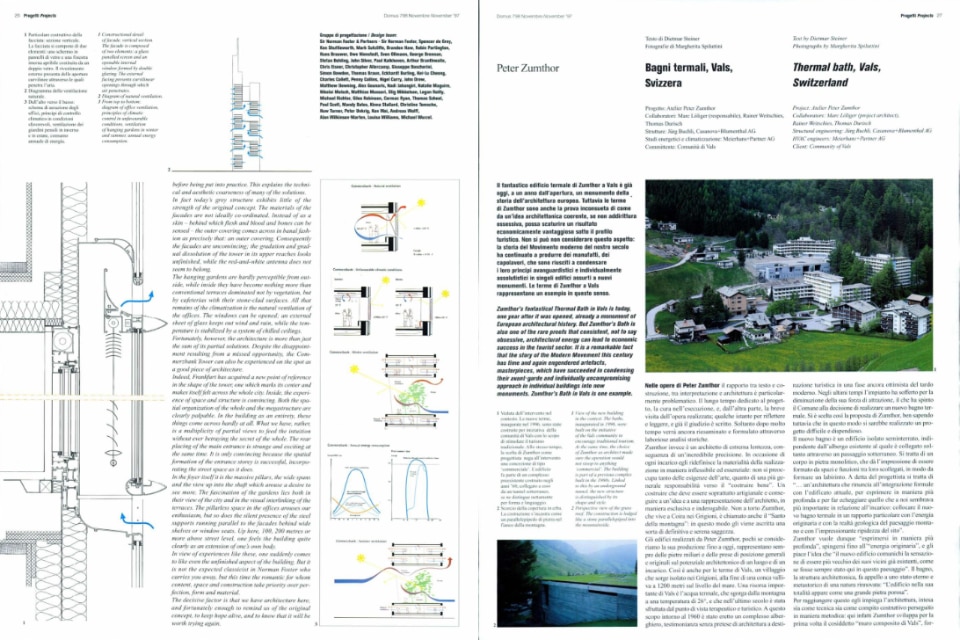
Zumthor’s fantastical Thermal Bath in Vals is today, one year after it was opened, already a monument of European architectural history. But Zumthor’s Bath is also one of the rare proofs that consistent, not to say obsessive, architectural energy can lead to economic success in the tourist sector.
It is a remarkable fact that the story of the Modern Movement this century has time and again engendered artefacts, masterpieces, which have succeeded in condensing their avant-garde and individually uncompromising approach in individual buildings into new monuments. Zumthor’s Bath in Vals is one example.
The relationship between text and building, between interpretation and architecture, is particularly problematic in the works of Peter Zumthor. The lengthy, steadfast draft stage, the labour of implementation, and the – by contrast, brief-visit to the finished work, a period of reading and thinking, and lo and behold, the judgement is made and preserved in black and white. Only much later is it reconsidered and re-assessed by long-winded historical analyses.
Peter Zumthor on the other hand is an architect of extreme slowness as a consequence of incredible exactitude. He redefines the materiality of the realization anew with every commission. Unbending and fundamental. He has recourse not so much to the claim of art, as to a far more fundamental responsibility for “correct building”. It must be craft-based above all, and follow an idea of the architect's. Exclusively and unconditionally. With some justice, Peter Zumthor, who lives in Chur in the Swiss canton of Graubunden, is also known as the “Saint ofthe Moun tains”. Thus a kind of definitive, detached wisdom is defined.
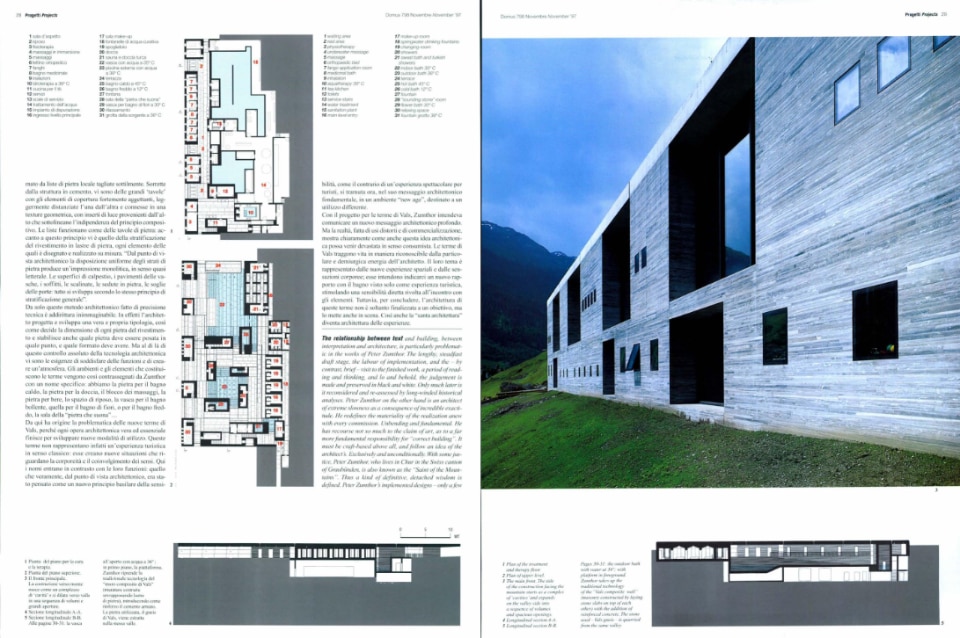
Peter Zumthor's implemented designs – only afew in his oeuvre to date – are always milestones as well as basic and unique statements on the architectural potential ofa place and a task. This also applies to the Thermal Bath at Vals. The town is situated in a remote spot at the end of a deep valley in Graubünden, 1200 metres above sea-level. An important resource in Vals is its hot spring; the water bubbles out of the mountainside at 26°, and has been exploited for therapeutic and tourist purposes since the 19th century.
In this connexion, a hotel complex was built in 1960, an innocuous witness to the late, but still optimistic, modern movement in tourist architecture. The complex suffered in recent times from a lack of attractiveness, which led to a decision by the local authority to construct a new thermal bath. The council came down in favour of a proposal by Peter Zumthor, well aware that this would involve the execution of a difficult and expensive project.
the architecture of the Thermal Bath not just serves the end, it stages it too.
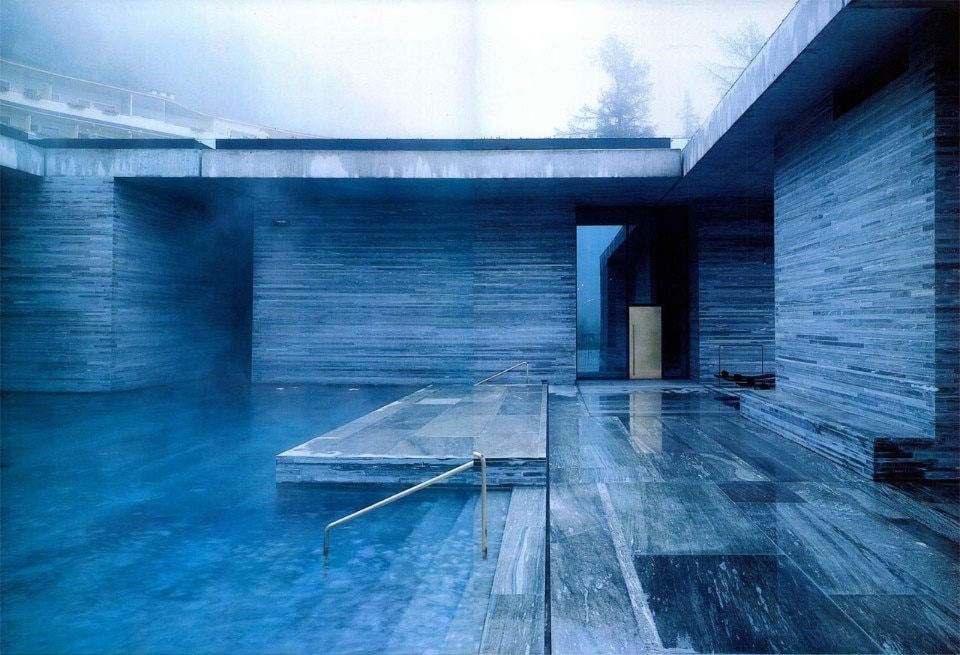
The new thermal bath stands alone, half sunk into the earth; it is detached from the existing hotel complex, being connected to it only by an underground passage. A monolithic stone structure, which arouses the impression that the rooms and uses have broken out in labyrinthine fashion. The architect’s statement by way of explanation: it is “an architecture which renounces formal integration into the existing buildings in order to bite more deeply, to suggest what seemed to us more fundamental in connexion with the task in hand: namely, to place the new thermal bath in a particular relationship with the primal strength and geological substance of the mountain scenery and the impressive relief of the topography”.
In other words, with this project Zumthor wants to “bite more deeply”; he wants to push forward to the “primal strength”, and he likes the idea that “the new structure conveys the feeling that it is older than its existing neigh-hours, that it has always been here in this landscape”.
The bath, the structure, appeals to an eternal, a trans historic condition of a new nature. “The building in its entirety seems like a great porous stone”. But in order to achieve this, the architecture must step in. As a technique, as a methodically constructive intention, Zumthor develops anew what is now known as “Vals laminated stonework” (Valser Verbundmauerwerk): thinly cut belts of local stone.
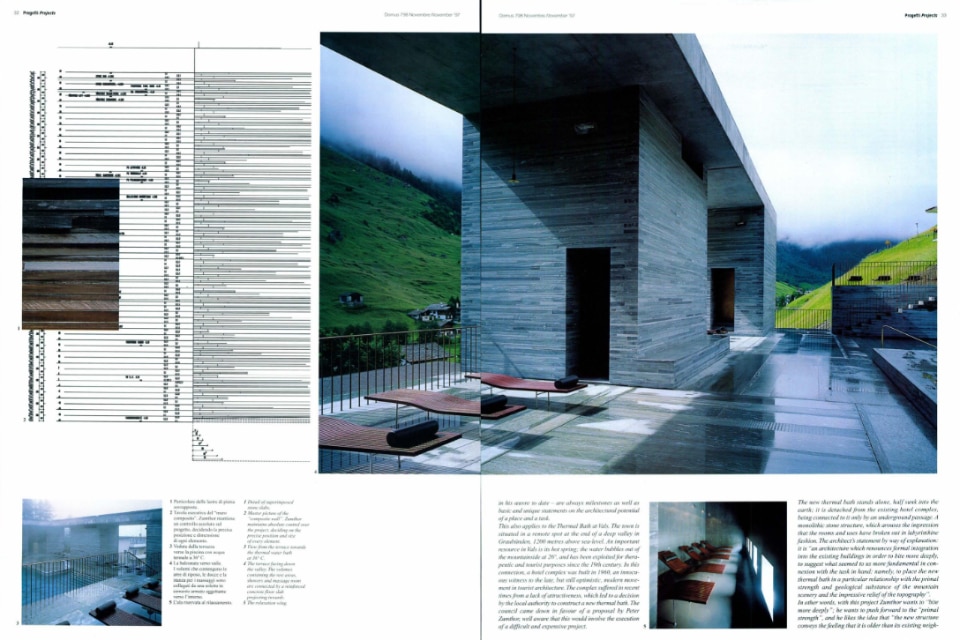
Borne by the structure of the concrete, large “tables” with widely projecting ceiling elements, put together, finely distanced one from the other, into a geometric pattern, with slits to let the light in from above – these emphasizing the independence of the compositional principle. They come across as stone tables. The lamination principle is assigned by the cladding of the stone slabs, where every part is drawn and measured: “looked at architecturally, the simple lamination of the stone produces an almost literally monolithic impression”.
Promenades, pool bottoms, ceilings, staircases, stone benches, doorways – everything develops according to the same consistent lamination principle This architectural method based on a technical postulate is in itself unimaginable. The architect indeed draws and develops the typology and dimensions of the individual cladding stones, and also prescribes which stone is to be placed where in what size. Over and above this absolute technical control of the architecture, we have the concept of use and atmosphere. The rooms and volumes of the Bath are defined and designated by Zumthor. Thus we have a sweating-stone, a showering-stone, a massage block, a drinking stone, a relaxation room, a fire-bath, a blossom-bath, a cold bath, a sound-stone...
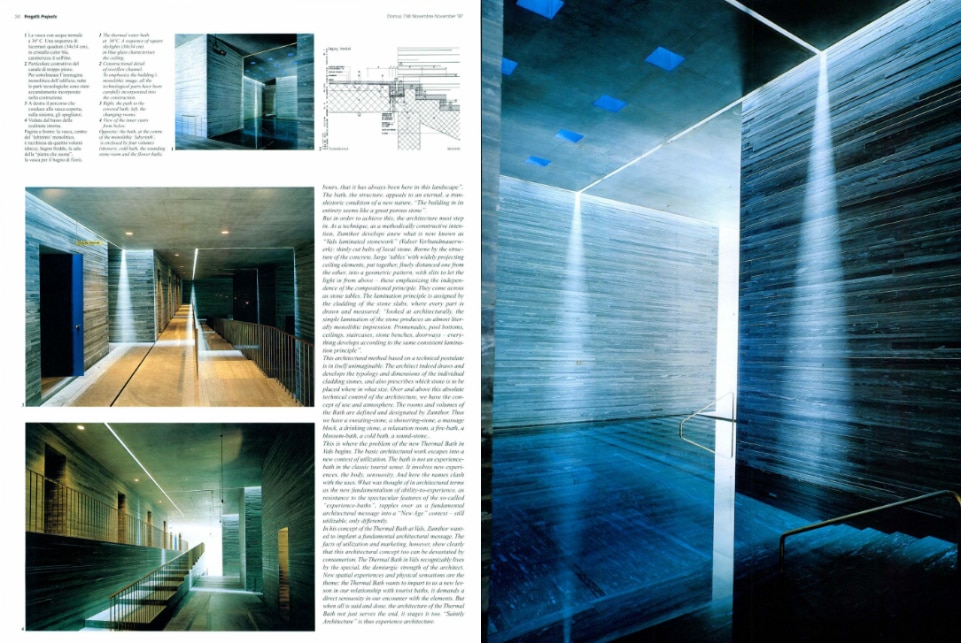
This is where the problem of the new Thermal Bath in Vals begins. The basic architectural work escapes into a new context of utilization. The bath is not an experience-bath in the classic tourist sense. It involves new experiences, the body, sensuosity. And here the names clash with the uses. What was thought of in architectural terms as the new fundamentalism of ability-to-experience, as resistance to the spectacular features of the so-called “experience-baths", topples over as a fundamental architectural message into a “New Age’’ context – still utilizable, only differently.
In his concept of the Thermal Bath at Vals, Zumthor wanted to implant a fundamental architectural message. The facts of utilization and marketing, however, show clearly that this architectural concept too can be devastated by consumerism. The Thermal Bath in Vals recognizably lives by the special, the demiurgic strength of the architect. New spatial experiences and physical sensations are the theme: the Thermal Bath wants to impart to us a new lesson in our relationship with tourist baths, it demands a direct sensuosity in our encounter with the elements. But when all is said and done, the architecture of the Thermal Bath not just serves the end, it stages it too. “Saintly Architecture” is thus experience architecture.

